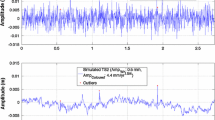Abstract
The classical least-squares (LS) algorithm is widely applied in practice of processing observations from Global Satellite Navigation Systems (GNSS). However, this approach provides reliable estimates of unknown parameters and realistic accuracy measures only if both the functional and stochastic models are appropriately specified. One essential deficiency of the stochastic model implemented in many available GNSS software products consists in neglecting temporal correlations of GNSS observations. Analysing time series of observation residuals resulting from the LS evaluation, the temporal correlation behaviour of GNSS measurements can be efficiently described by means of socalled autoregressive moving average (ARMA) processes. For a given noise realisation, a well-fitting ARMA model can be automatically estimated and identified using the ARMASA toolbox available free of charge in MATLAB® Central.
In the preliminary stage of applying the ARMASA toolbox to residual-based modelling of temporal correlations of GNSS observations, this paper presents an empirical performance analysis of the automatic ARMA estimation tool using a large amount of simulated noise time series with representative temporal correlation properties comparable to the GNSS residuals. The results show that the rate of unbiased model estimates increases with data length and decreases with model complexity. For large samples, more than 80% of the identified ARMA models are unbiased. Additionally, the model error representing the deviation between the true data-generating process and the model estimate converges rapidly to the associated asymptotical value for a sufficiently large sample size with respect to the correlation length.
Similar content being viewed by others
References
Akaike H., 1973. Information theory and an extension of the maximum likelihood principle. In: Petrov B.N. and Csaki F. (Eds.), 2nd International Symposium on Information Theory, Tsahkadsor, Armenia, USSR, September 2–8, 1971. Akadémiai Kiadó, Budapest, Hungary, 267–281.
Borre K. and Tiberius C., 2000. Time series analysis of GPS observables. Proceedings of the 13th International Technical Meeting of the Satellite Division of The Institute of Navigation (ION GPS 2000), Salt Lake City, UT, September 2000, 1885–1894 (online at http://kom.aau.dk/~borre/engineer/ion00.pdf).
Brockwell P.J. and Davis R.A., 2002. Introduction to Time Series and Forecasting, 2nd Edition. Springer, New York.
Broersen P.M.T., 1998. The quality of models for ARMA processes. IEEE Trans. Signal Process., 46, 1749–1752.
Broersen P.M.T, 2000a. Finite sample criteria for autoregressive order selection. IEEE Trans. Signal Process., 48, 3550–3558.
Broersen P.M.T., 2000b. Facts and fiction in spectral analysis. IEEE. Trans. Instrum. Meas., 49, 766–772.
Broersen P.M.T., 2000c. Autoregressive model orders for Durbin’s MA and ARMA estimators. IEEE Trans. Signal Process., 48, 2454–2457.
Broersen P.M.T., 2002. Automatic spectral analysis with time series models. IEEE Trans. Instrum. Meas., 51, 211–216.
Broersen P.M.T., 2006. Automatic Autocorrelation and Spectral Analysis. Springer-Verlag, London, U.K.
Broersen P.M.T. and de Waele S., 2004. Finite sample properties of ARMA order selection. IEEE Trans. Instrum. Meas., 53, 645–651.
Broersen P.M.T. and Wensink H.E., 1993. On finite sample theory for autoregressive model order selection. IEEE Trans. Signal Process., 41, 194–204.
Brunner F.K., Hartinger H. and Troyer L., 1999. GPS signal diffraction modelling: the stochastic SIGMAΔ model. J. Geodesy, 73, 259–267, DOI: 10.1007/s001900050242.
Burg J.P., 1967. Maximum entropy spectral analysis. Proceedings of the 37th Meeting of Society Exploration Geophysicists, 1967. Reprinted in: Childers D.G. (Ed.), Modern Spectrum Analysis. IEEE Press, New York, 1978, 34–39.
Dach R., Hugentobler U., Fridez P. and Meindl M., 2007. Bernese GPS Software Version 5.0. Astronomical Institute, University of Bern, Bern, Switzerland.
Durbin J., 1959. Efficient estimation of parameters in moving average models. Biometrika, 46, 306–316, DOI: 10.1093/biomet/46.3-4.306.
Durbin J., 1960. The fitting of time series models. Rev. Inst. Int. Stat., 28, 233–243.
Euler H.J. and Goad C.C., 1991. On optimal filtering of GPS dual frequency observations without using orbit information. Bull. Geod., 65, 130–143, DOI: 10.1007/BF00806368.
Hannen E.J. and Rissanen J., 1982. Recursive estimation of mixed autoregressive moving-average order. Biometrika, 69, 81–94, DOI: 10.1093/biomet/69.1.81.
Howind J., 2005. Analyse des stochastischen Modells von GPS-Trägerphasenbeobachtungen. Deutsche Geodätische Kommission, DGK C584, Munich, Germany.
Klees R. and Broersen P., 2002. How to Handle Colored Observation Noise in Large-Scale Least-Squares Problems — Building the Optimal Filter. DUP Science, Delft University Press, Delft, The Netherlands.
Klees R., Ditmar P. and Broersen P., 2003. How to handle colored observation noise in large least-squares problems. J. Geodesy, 76, 629–640, DOI: 10.1007/s00190-002-0291-4.
Li J., Miyashita K., Kato T. and Miyazaki S., 2000. GPS time series modeling by autoregressive moving average method: application to the crustal deformation in central Japan. Earth Planets Space, 52, 155–162.
Luo X., Mayer M. and Heck B., 2008. Improving the stochastic model of GNSS observations by means of SNR-based weighting. In: Sideris M.G. (Ed.), Observing our Changing Earth. International Association of Geodesy Symposia, 133. Springer Verlag, Berlin, Heidelberg, Germany, 725–734, DOI: 10.1007/978-3-540-85426-5_83.
Luo X., Mayer M. and Heck B., 2011. Analysing time series of GNSS residuals by means of AR(I)MA processes. In: Sneeuw N., Novák P., Sansò F. and Crespi M. (Eds.), VII Hotine-Marussi Symposium. International Association of Geodesy Symposia, 137. Springer-Verlag, Berlin, Heidelberg, Germany (in print).
Priestly M.B., 1981. Spectral Analysis and Time Series. Academic Press, London, U.K.
Schön S. and Brunner F.K., 2008. A proposal for modelling physical correlations of GPS phase observations. J. Geodesy, 82, 601–612, DOI: 10.1007/s00190-008-0211-3.
Shibata R., 1976. Selection of the order of an autoregressive mode by Akaike’s information criterion. Biometrika, 63, 117–126, DOI: 10.1093/biomet/63.1.117.
Stoica P. and Moses R., 1997. Introduction to Spectral Analysis. Prentice Hall, New Jersey, U.S.
Tiberius C. and Kenselaar F., 2003. Variance component estimation and precise GPS positioning: case study. J. Surv. Engn., 129, 11–18, DOI: 10.1061/(ASCE)0733-9453(2003)129:1(11)).
Wang J., Satirapod C. and Rizos C., 2002. Stochastic assessment of GPS carrier phase measurements for precise static relative positioning. J. Geodesy, 76, 95–104, DOI: 10.1007/s00190-001-0225-6.
Wheelon A.D., 2001. Electromagnetic Scintillation — I. Geometricaloptics. Cambridge University Press, Cambridge, U.K.
Author information
Authors and Affiliations
Corresponding author
Rights and permissions
About this article
Cite this article
Luo, X., Mayer, M. & Heck, B. Verification of ARMA identification for modelling temporal correlations of GNSS observations using the ARMASA toolbox. Stud Geophys Geod 55, 537–556 (2011). https://doi.org/10.1007/s11200-011-0033-2
Received:
Revised:
Accepted:
Published:
Issue Date:
DOI: https://doi.org/10.1007/s11200-011-0033-2




